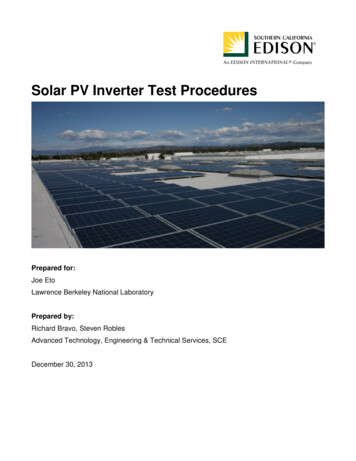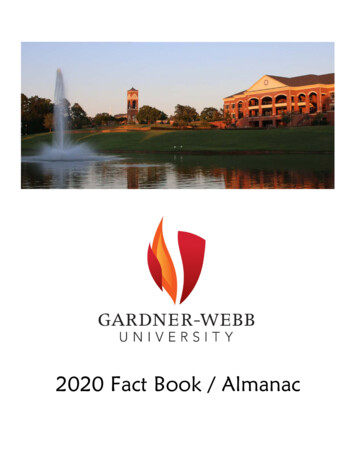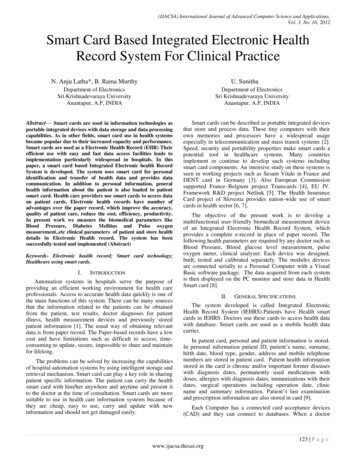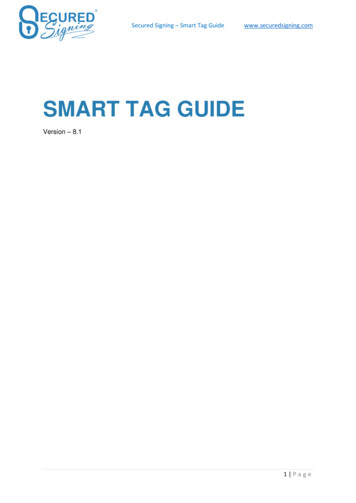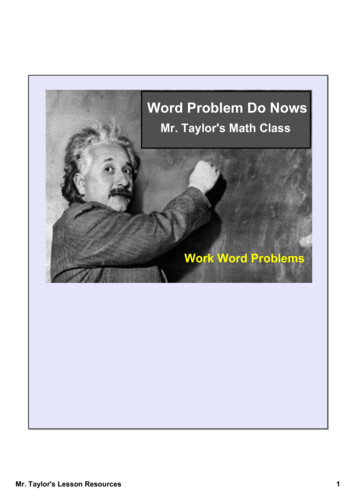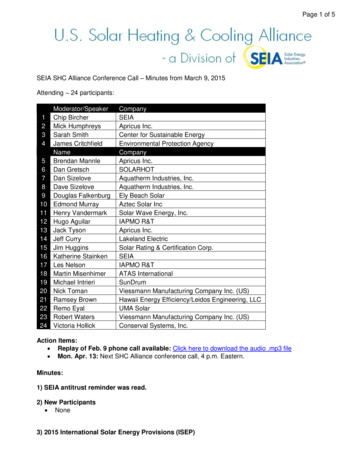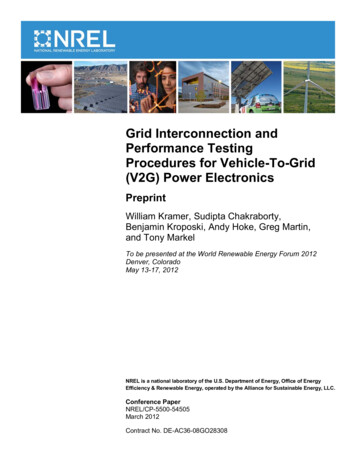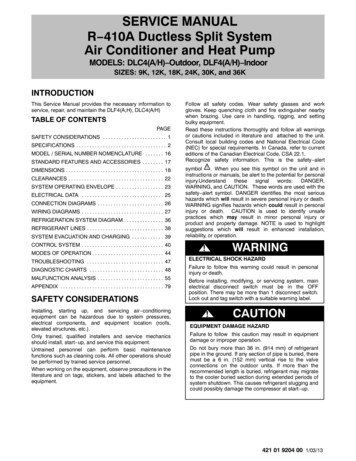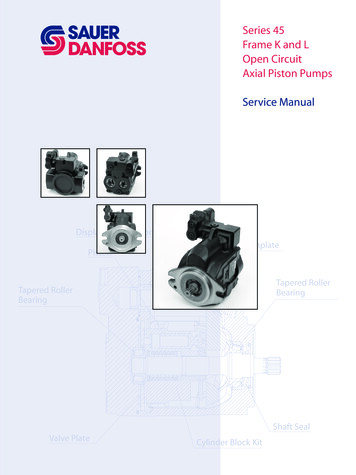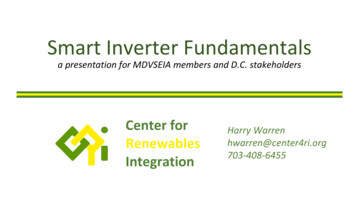
Transcription
Smart Inverter Fundamentalsa presentation for MDVSEIA members and D.C. stakeholdersCenter forRenewablesIntegrationHarry Warrenhwarren@center4ri.org703-408-6455
Today’s Presentation About the Center for Renewables Integration What is a ”smart inverter”? Standards development and applications Status of standards development – IEEE-1547-2018TM Ride-through Voltage and reactive/active power control Communications Battery storage Adoption of smart inverter standards in local jurisdictions2
Center for Renewables IntegrationCenter for Renewables Integration, Inc.is a 501(c)(3) non–profit organization,founded in 2017,dedicated to educating and working with state and local policymakers, and other keystakeholdersseeking to enable high levels of clean energy deployment while maintaining gridreliability at the lowest cost.CRI’s co-founders areJeanne Fox, Educatorformer President, New Jersey Board of Public UtilitiesKerinia Cusick, Principal Consultant, Distributed Energy Innovationformer Vice President, Energy Storage and Managing Director, Government Affairs, SunEdisonHarry Warren, President, CleanGrid Advisorsformer President, Washington Gas Energy Services3
What is a “Smart Inverter”“Smart Inverter” is a commonly used, butimprecisely defined, term that refers toinverters with some or all of the followingadvanced features: Autonomous “ride-through” capabilities Autonomous voltage and reactive/activepower control capabilities Communication capabilitiesMany inverters on the market today areequipped with advanced features, and thecompletion of new national standards willresult in these features being incorporatedinto all inverters.Illustration – Clean Energy Reviews4
Standards Development and ApplicationsTBDCommunications to supportgrid services and externalinverter control.2022IEEE 1547-2018 compliant”Smart Inverters” AvailableTODAYAdvanced inverter featurescompliant with interimstandardsSTANDARDSAPPLICATION COMPLEXITYSolar onRadial LinesSolar on Spot or Area NetworksSolar plus Storage5
Status of Standards Development IEEE-1547-2018TM, “Standard for Interconnection andInteroperability of Distributed Energy Resources withAssociated Electric Power Systems Interfaces” waspublished in April 2018. A companion equipment testing standard IEEE-1547.1 isunder development and is scheduled for publication inthe first half of 2020. A companion certification testing protocol UL-1741 willlikely be released shortly after IEEE 1547.1 Inverters with UL certification could be available as earlyas late 2020, with a broad range of certified productsavailable by the start of 2022.6
Ride-ThroughRide-though allows an inverter to continueto function through a short frequency orvoltage disturbance on the grid.California Blue Cut Fire 2016 – Transmission Fault Cleared in 41.7milliseconds Inverters in place today trip off line veryquickly in response to frequency andvoltage fluctuations, but do not resumeoperation quickly. As renewable energypenetration on the grid increases, thiscould cause massive amounts of powerto be lost due to transient fluctuations. Potential problems in states with highrenewables penetration (California andHawaii) have led those states to developtheir own inverter standards (e.g.California Rule 21).Figure - NERC7
Ride-ThroughA PJM stakeholder process is almostcompleted to establish the ride-throughmodes of operation and settings within thenew IEEE-1547-2018 framework that will bestassure future grid stability within the RTO. PJM’s efforts will result in recommendedpractices to be adopted by states fordistributed energy resources. Therecommendations are in the final stages ofinternal approval and should be finalizedsoon. PJM has no authority overdistribution-connected resources, so statesneed to adopt the recommendations intotheir regulations, utility tariffs and otherpolicies and practices as needed.8
Voltage and Reactive/Active Power ControlDistributed energy resources that use inverters (solar PVsystems and batteries) can introduce voltage fluctuationsinto distribution grids as their power production ordischarge vary over time. They also need to respond todistribution grid voltage status. Smart inverter voltage control features can mitigateimpacts on the distribution system by modulating realand reactive power through one of a number ofoperating mode alternatives. By mitigating distribution system impacts, smartinverters can increase the “hosting capacity” ofdistribution circuits, allowing deeper penetration ofrenewables without costly distribution system upgrades. There is the potential for smart inverters to improvevoltage control on distribution lines being caused byother factors (e.g. load fluctuations).Tables – IEEE-1547-20189
CommunicationsIEEE-1547-2018 covers certaininverter capabilities needed to allowutilities to control and communicatewith inverters. This control couldprovide improved gridmanagement. Utility control over smartinverters raises additional issues,however, such as secure, low costcommunications systems anddistributed resourcemanagement systems (DERMS)IEEE 2030.5/CSIPFigure – IEEE-1547-201810
Battery StorageBattery storage systems requireinverters /charge controllers, andinclude additional controls tomanage various operatingmodes.These issues are not fully coveredunder IEEE-1547-2018 and needto be addressed separately.IEEE 2030.2.1-2019Proposed Use: The operational characteristics of a small generatorfacility upon which the applicant’s technical review is based and underwhich the small generator facility is bound to operate upon theexecution of the interconnection agreement. The proposed use for asmall generator facility may include a combination of electric generatorsand energy storage devices operating in specified modes duringspecified time periods including but not limited to export, loadmanagement, backup, and market participation.Net System Capacity: The nameplate capacity of a small generatorfacility, or the total of the nameplate capacities of the units comprising asmall generator facility, as designated by the manufacturer(s) of theunit(s) minus the consumption of: electrical power of the unit(s), and ifapplicable, as limited through the use of a control system, powerrelay(s), or other similar device settings or adjustments.Inadvertent Export: The unscheduled export of active power from aGenerating Facility, beyond a specified magnitude and for a limitedduration, generally due to fluctuations in load-following behavior.11
Adoption of Smart Inverter Standards in Local Jurisdictions12
Adoption of Smart Inverter Standards in Local JurisdictionsMarylandIn September 2018, the Maryland PSC adopted revised interconnection regulationsallowing utilities and interconnecting customers to use smart inverter features approvedunder interim standards by mutual agreement. Equipment certified under the latest published editions of IEEE 1547, IEEE 1547.1 and UL 1741 shall bepermitted to be used for monitoring or control upon mutual agreement of the utility and theinterconnection customer.13
Adoption of Smart Inverter Standards in Local JurisdictionsMarylandIn September 2019, the Maryland PSC published revised interconnection regulationsthat set forth requirements for the use of smart inverters compliant withIEEE-1547-2018TM “Smart Inverter” means any inverter hardware system certified to be compliant with IEEE 1547-2018 orsubsequent revisions to these standards.“Utility required inverter settings profile” means smart inverter settings for a small generator facility that areestablished by a utility.(a) A “state-wide” utility required inverter settings profile” or “grid code” is a set of smart inverter settingsoptimized for use state-wide that can be used by utilities and manufacturers in establishing defaults.(b) A “default” utility required inverter settings profile is a utility set of default smart inverter settings optimizedfor use across a utility’s service territory.(c) A “site-specific” utility required inverter settings profile is a set of smart inverter settings optimized for use ata specific site on a utility’s electric system.14
Adoption of Smart Inverter Standards in Local JurisdictionsMaryland Smart Inverters.(1) After January 1, 2022, any small generator facility requiring an inverter that submits an interconnectionrequest shall use a smart inverter with either a default or site-specific utility required inverter settings profile asdetermined by a utility.(2) Any small generator facility may replace an existing inverter with a similar spare inverter that was purchasedprior to January 1, 2022 for use at the small generator facility.(3) Prior to January 1, 2022, all utilities will establish default utility required inverter settings profiles for smartinverters pursuant to §N(5) of this Section. A utility may use a state-wide utility required inverter settings profileas their default utility required inverter settings profile.(4) To the extent reasonable, pursuant to any modifications required by §N(5) of this Section, all utility requiredinverter setting profiles shall be consistent with applicable smart inverter recommendations from PJMInterconnection, LLC that are applicable.15
Adoption of Smart Inverter Standards in Local JurisdictionsMaryland Smart Inverters.(5) A default utility required inverter settings profile shall be established by a utility to optimize the safe andreliable operation of the electric distribution system, and shall serve the following objectives:(a) The primary objective is to incur no involuntary real power inverter curtailments incurred during normaloperating conditions and minimal real power involuntary curtailments during abnormal operatingconditions.(b) The secondary objective is to enhance electric distribution system hosting capacity and to optimize theprovision of grid support services.(6) A site-specific utility required inverter settings profile may be established by a utility as necessary to optimallymeet the objectives established in §N(5) of this Section.(7) All default and site-specific utility required inverter settings profiles will be documented in interconnectionagreements.(8) A default utility required inverter settings profile will be published on the utility’s website.(9) A list of acceptable smart inverters shall be published on a utility’s website.16
Adoption of Smart Inverter Standards in Local JurisdictionsMaryland In its report to the Commission accompanying the draft proposed regulations, the Commission Staff noted that:“the Workgroup proposes that utilities determine their default DU-URPs by the end of 2020. In early 2021, it isproposed that the Workgroup meet in a workshop to discuss each utility’s default DU-URPs and the rationalebehind them. If consensus is not reached at the workshop on a state-wide Preferred URP, the Workgroup willschedule additional meetings in an attempt to gain consensus. The end result of the workshop will be either arecommendation by the Workgroup to the Commission for a state-wide Preferred URP71 or the steps needed toovercome any non-consensus in developing a state-wide Preferred URP.” The Commission asked that the PC-44 Interconnection Work Group continue to meet: The Smart Inverter Subgroup will continue to report periodically on the status of IEEE 1547.1 and UL 1741completion at WG meetings Utilities will provide periodic report-outs on their progress developing DU-URPs at future WG meetings The next Maryland Interconnection Work Group meeting is scheduled for January 28, 2019.17
Adoption of Smart Inverter Standards in Local JurisdictionsDelawareCRI made a presentation to the Delaware Public Service Commission in August 2018 on the fundamentalsof smart inverters and the IEEE and UL standards development process. No specific processes todetermine standards are yet underway.VirginiaOn December 3, 2019 the VASCC published new draft interconnection regulations for review andcomment. See PUR-2018-00107. Comments are due February 21, 2020.No specific references to smart inverter adoption or standards developments were included in proposedregulations put forward by the Commission Staff in September 2019. The Staff did note in its filing, thataddressing smart inverters might be important once all applicable standards are in place.18
Center for Renewables IntegrationFurther Reading“It’s Time for States to Get Smart About Smart Inverters”,Center for Renewables Integration, Inc., September g the Grid Smarter: Primer on Adopting the New IEEE Standard 1547 -2018 for Distributed EnergyResources”, Interstate Renewable Energy Council, January verters/Maryland PSC Staff filing Maillog #226408, and further proceedings in Maryland Rulemaking 68.https://www.psc.state.md.us19
District of Columbia’sDistributed Energy Resources IntegrationTechnical Challenges and OpportunitiesJorge Camacho, P.E.IEEE Std 1547 Conformity Assessment Steering Committeej.a.camacho@ieee.org
Figure 1 – IEEE STD 1547-2018
Clause 9 – IEEE STD 1547-2018Secondary Area Networks [LVAC]“Monitor instantaneous power flow at thePCC of the DER interconnected to thesecondary grid or spot network for reversepower relaying, minimum import relaying,dynamically controlled inverter functionsand similar applications to prevent reversepower flow through network protectors.”
The Function:Monitor instantaneous power flow at the PCC
Independent, Transparent, and Technical SoundDER Integration ProcessIEEE Conformity Assessment Program (ICAP) IEEE approved Commissioning Agent (CA)https://ieeexplore.ieee.org/document/8786948
Impact of Pepco Minimum-Import Requirementsfor PV on Secondary Spot Networks in DC First cost (EPC) Financial uncertainty Lost environmental benefits O&M expense
Evolution of Pepco Operating Requirementsfor PV on Secondary Spot Networks in DC180 KW (AC) - ATI June 2018200 KW (AC) - ATI October 2019Controls 18 KW minimum import 38 KW minimum import Relay mentioned but inverter-basedcurtailment acceptable Protection relay with specific functionsrequired; relay model and settingsmust be approved by Pepco Curtailment optional
Evolution of Pepco Operating Requirementsfor PV on Secondary Spot Networks in DC180 KW (AC) - ATI June 2018200 KW (AC) - ATI October 2019Curtailment/Trip Timing None specified Trip “must occur instantaneously” Relay “must trip before the NetworkProtector”
Evolution of Pepco Operating Requirementsfor PV on Secondary Spot Networks in DC180 KW (AC) - ATI June 2018200 KW (AC) - ATI October 2019Communications System events to be reported to Pepcoby e-mail System to provide metering and statusdata to Pepco by telemetry Customer to provide Pepco with webaccess to system monitoring Data points and format specified byPepco Communications medium not specified Customer to purchase and installPepco radio communications box
Evolution of Pepco Operating Requirementsfor PV on Secondary Spot Networks in DC180 KW (AC) - ATI June 2018200 KW (AC) - ATI October 2019Witness Test/Commissioning Test to demonstrate curtailment Test to demonstrate tripping and(optional) curtailment Commissioning to demonstratetelemetry of metering and status toPepco
IEEE 1547 DER Interconnection Standardfor the MDV-SEIA Workshop,“Maximizing the Use of Advanced Inverters and the New IEEE 1547-2018Standards to Meet the District of Columbia’s Solar and Clean Energy Mandates”Charlie Vartanian, PE – Pacific Northwest National Laboratory, and IEEE 1547 Working GroupDecember 5, 2019SEIA Headquarters, Washington DC
Disclaimer and Acknowledgment This presentation on IEEE 1547-2018 represents the author’sviews and are not the formal position, explanation or positionof the IEEE, the IEEE Standards Association, or PNNL. This slide deck has been peer-reviewed by IEEE StandardCoordination Committee 21 (SCC21) and IEEE P1547Officers. The presenter acknowledges the contribution of the IEEE1547-2018 Working Group, Balloters and Officers
Outline, Workshop IEEE 1547 Module3Red-colored text copied from event Agenda1. IEEE 1547 Introduction, a high level overview of IEEE 15472. IEEE 1547-2018 Revision Overview, focusing on new requirementsGeneral RequirementsReactive Power (VAR) Capacity and Voltage Regulation ModesAbnormal Condition ResponseInteroperability RequirementsP1547.9 Future Guide for DER-ES Interconnection3. Energy Storage(ES), and ES PV Interconnection Considerations4. DER and Distribution Networks Considerations (separate slide deck)5. IEEE 1547-2018 Adoption, and early movers, CA Rule 21, HA Rule 14, and UL-1741-SA3
IEEE Std 1547-2018 Introduction4
Importance of IEEE 1547 Energy Policy Act (2005) Cites and requires consideration of IEEE 1547 Standards andBest Practices for Interconnection; all states use or cite 1547. Energy Independence and Security Act (2007) IEEE cited as a standards developmentorganization partner to NIST as Lead to coordinate framework and roadmap for Smart GridInteroperability standards and protocols {IEEE 1547 & 2030 series being expanded}; Federal ARRA (2009) Smart Grid & High Penetration DER projects {use IEEE stds}.5
IEEE 1547-2018 Scope and PurposeTitle: Standard for Interconnection and Interoperability of Distributed EnergyResources with Associated Electric Power Systems InterfacesScope: This standard establishes criteria and requirements for interconnectionof distributed energy resources (DER) with electric power systems (EPS), andassociated interfaces.Purpose: This document provides a uniform standard for the interconnectionand interoperability of distributed energy resources (DER) with electric powersystems (EPS). It provides requirements relevant to the interconnection andinteroperability performance, operation, and testing, and, safety, maintenanceand security considerations.Changes from IEEE 1547-2003 shown in red
IEEE 1547 Interconnection Example Use in United StatesIEEE 1547Interconnection Systemand TestRequirements Voltage Regulation Ride-through Interoperability Islanding .NFPA70 (NEC2020 Edition)IEEE 1547.1UL resSafety, Utility interactivetestsPerformance IslandingCertification Reconnection O/U Voltageand Frequency Synchronization DC injection .InstallationCode 690,691 Solar PV 692 Fuel Cells 694 Wind Turbines 700-702 Emergency /Standby Systems 1547.1 Tests 705 Interconnected PowerProduction Sources Protection againstrisks of injuryto persons 706 Energy StorageSystems Specific tests for varioustechnologies .Local interconnection processes and procedures 710 Stand alone or Islanded UL3001 Systems(NEC info. Based on NEC 2018 First Revision)
IEEE 1547-2018 Document Outline (Clauses)1.Introduction2.Overview3.Normative references, definitions and acronyms4.General specifications and requirements5.Reactive power, voltage/power control6.Response to Area EPS abnormal conditions7.Power quality8.Islanding9.Distribution secondary grid and spot networks10. Interoperability11. Test and verificationFocusfor this tutorial
1547-2018 General Specifications &RequirementsClause 49
1.4 General remarks and limitations Applicable to all DERs connected at typical primary or secondary distributionvoltage levels.– Removed the 10 MVA limit from previous versions.– BUT: Not applicable for transmission or networked sub-transmissionconnected resources. Specifies performance and not design of DER. Specifies capabilities and functions and not the use of these. Does not address planning, designing, operating, or maintaining the AreaEPS with DER. Emergency and standby DER are exempt from certain requirements of thisstandard.– E.g., voltage and frequency ride-through, interoperability andcommunications. Gives precedence to synchronous generator (SG) standards for DER with SGunits rated 10 MVA and greater.– E.g., IEEE Std C50.12, IEEE Std C50.13.10
Reactive power, voltage/power controlClause 511
New Reactive PowerRequirements
Categories of DER grid support – DER’s VAR capacity and voltageregulation capabilities CategoryA CategoryB Meets minimum performance capabilities needed for Area EPSvoltage regulationReasonably attainable by all state-of-the-art DER technologiesReactive power capability: 0.25 p.u. lagging, 0.44 p.u. leadingMeets all requirements in Category A plus Supplemental capabilities for high DER penetration, where theDER power output is subject to frequent large variations.Attainable by most smart invertersReactive power capability: 0.44 p.u. lagging, 0.44 p.u. leadingCategory assignment specified by Area EPS Operator
Active voltage regulation capability requirementsDER must possess capability – implementation is at thediscretion of area EPS Operator (mode and parameters)Capability required of all DER – (Cat A, B)Constant power factor modeConstant reactive power mode (“reactive power priority”)Voltage-reactive power mode (“volt-var”)“State-of the art” DER – Cat BActive power-reactive power mode (“watt-var”)Voltage-active power mode (“volt-watt”).
Response to abnormal conditionsClause 615
Assignment of new IEEE 1547-2018 Performance CategoriesNormal and abnormal operatingperformance categoriesRideThroughCategory s Costs Marketsegment Etc.1CategoryIICategoryIIIState Regulator, Area EPS or bulk systemoperator, quirements(AGIRs)1Control / trip settings Ranges of allowablesettings Default parametersImpact Assessment Technical conditions: Type, capacity, & future penetration of DERs Type of grid configuration, etc. Non-technical issues: DER use case, impacts onenvironment, emissions, and sustainability, etc. StakeholderEngagementDistribution utilitiesBulk systemoperators & plannersDER developersOthers Category III Greatest ride-through capabilities Category B Greatest voltage support capabilities (most inverter-based DERs)
Performance Categories –Abnormal Operating ConditionsRide Through CapabilitiesCategoryI Essential bulk power system needs Attainable by all state-of-the-art DER technologies. CategoryII CategoryIII Supports bulk power system reliability requirements, e.g. ride throughCoordinated with existing reliability standards to avoid tripping for awider range of disturbances ( more robust than Category I)Designed for bulk system needs, and distribution systemreliability/power quality needsCoordinated with existing standards for very high DER levels
Categories for DER response to abnormal EPS conditionsCategoryObjectiveFoundationIEssential bulk system needs andreasonably achievable by all currentstate-of-art DER technologiesGerman grid code for synchronousgenerator DERIIFull coordination with bulk powersystem needsBased on NERC PRC-024, adjusted fordistribution voltage differences (delayedvoltage recovery)IIIRide-through designed for distributionsupport as well as bulk systemBased on California Rule 21 and HawaiiRule 14HCategory II and III are sufficient for bulk system reliability.18
InteroperabilityClause 1019
Interoperability requirementsIEEE 1547-2018 defines communication interface20
List of Eligible Protocols21
Energy Storage(ES), and ES PVInterconnection ConsiderationsP1547.9 a Future Guide for ES-DER Interconnection22
Representative Grid Connected BESSIDENTIFY:AREA EPSLOCAL EPSPOCPCC (or POI)Source, AEPFrom, SANDIA REPORT, Installation of the First Distributed Energy Storage System (DESS) at American Electric Power (AEP),SAND2007-3580, June 200723
Representative BESS Single Line DiagramSource, AEPFrom, SANDIA REPORT, Installation of the First Distributed Energy Storage System (DESS) at American Electric Power (AEP),SAND2007-3580, June 200724
Representative BESS Plot PlanSource, AEPFrom, SANDIA REPORT, Installation of the First Distributed Energy Storage System (DESS) at American Electric Power (AEP),SAND2007-3580, June 200725
Power Capability vs Controlled Capacity vsRating at the Point of Common Coupling (PCC)12.47 kV15 kVA12.47 kV15 kVAMPCC 10 kW12 kVA 10 kWMPCC12 kVA 12 kVA10 kW12.47 kV15 kVA120/240V120/240V120/240V120/240VM12.47 kV15 kVA 10 kWMPCCPCC12 kVA10 kW12 kVA 10 kW10 kW10 kWWhat’s the interconnection rating and/or requirementat the PCC?Who determines? On what basis?Does amount of metered demand, and how its connected, have an impact?26
Without Updated Standards Plus Adoption by AHJ’s,Some Services from ES & PV ES Won’t Be Deliverable1547-2003 vs. new CA 21 &1547RevisionSource (original table): CA PUC Staff, AB2514 workshop, 3/25/2013
IEEE P1547.9 ProjectApproved by the IEEE SASB on March 8, 2018Title: Draft Guide to Using IEEE Standard 1547 for Interconnection of Energy Storage Distributed EnergyResources with Electric Power SystemsScope: This Guide provides information on and examples of how to apply the IEEE Std 1547, for theinterconnection of Energy Storage Distributed Energy Resources (DER ES). Scope includes DER ES connectedto area Electric Power Systems (local EPSs) that are capable of bidirectional real and reactive power flow, andare capable of exporting real power to the EPS. Guidance is also provided for non-exporting DER ES, such asUninterruptible Power Supply (UPS) type systems that support onsite loads, or Electric Vehicle (EV) chargers,with charging attributes that could have power system impacts, e.g. modulating rate of charge proportionallyto system frequency.Purpose: The purpose of this guide is to provide guidance on prudent and technically sound approaches tointerconnection of DER ES to power systems. This guideline will also consider ES-related topics not currentlyaddressed or fully covered in the main IEEE 1547 Standard document. For example:1). Guidance for interconnection of EV charging stations with the ability for exporting (i.e., bidirectional real orreactive power exchange) to the connected power system (i.e., "V2G").2). Guidance on when ES are or are not within the scope of P1547. For example, 1547.9 would expand on theexceptions for systems that are non-exporting, e.g. UPS that receive energy from the grid, but only use it forpremise loads while off-grid.3). Guidance on charging and generation constraints to minimize negative impacts in the distribution system.28
P1547.9 TIMELINEDatesFebruary 28, 2019June 6, 2019October 2019ActivitiesP1547.9 WG meeting – WG initiatedP1547.9 WG Meeting – Draft 1 initiatedP1547.9 WG Meeting (online meeting)StatusDonePlanPlanFebruary 2020P1547.9 WG Meeting (co-located with ESSB)PlanSummer 2020P1547.9 WG MeetingPlanFall/Winter 2020P1547.9 WG MeetingPlanSpring/Summer 2021 P1547.9 WG MeetingPlanTBDTBDTBDP1547.9 Ballot draft approved by WGP1547.9 To IEEE-SA for ballotIEEE Std 1547.9-20XX Published2912/12/2019
DER and Distribution NetworksConsiderationsSee Separate Slide Deck, M. Coddington, NREL30
Extract from IEEE 1547-2018 Subclause 9.1 “Network protectorsand automatic transfer scheme requirements”3112/12/2019
IEEE 1547-2018 Adoption,and early movers, CA Rule 21, HI Rule 14, and UL-1741-SA32
Update from P1547.1 WG Chair, Nov. 201933
UL-1741-SA, an interim solutionSource, UL Presentation, T. Zgonena, 11/1/201734
UL-1741-SA, an interim solutionSource, UL Presentation, T. Zgonena, 11/1/201735
UL-1741-SA, an interim solutionSource, UL Presentation, T. Zgonena, 11/1/201736
CA Rule 21Source, SCE Presentation, R. Salas, 9/14/201837
CA Rule 21Source, SCE Presentation, R. Salas, 9/14/201838
CA Rule 21Source, SCE Presentation, R. Salas, 9/14/201839
HI Rule 14Source, Enphase presentation, J. Berdner, 9/14/201840
HI Rule 1441
Questions?Charlie.Vartanian@pnnl.gov42
Backup Slides43
Reference Point of Applicability RPA is where performancerequirements apply IEEE 1547 specifies RPAdepending on three criteria:o Aggregate DER ratingo Average load demando Zero sequence continuity Generally:o PoC (DER terminals) for smalland load-immersed DERo PCC for large exportinginstallations
Enter Service criteria Prior to Enter Service or Return to Service after a trip, power system’s voltagemust be within specified voltage magnitude and frequency range continuously fora defined period Permit Service flag must be set to Enabled Power system voltage and frequency limits, and DER delay period are alladjustable within a defined range The DER must be capable of ramping up its power either continuously or in smallsteps ( 20%) after entering service– Exception: Smaller DER installations ( 500 kVA) can alternatively return to service in onestep after a randomized additional delay
Frequency Support120%70%20%-30% 56Default value offrequency deadbandwas reduced from100 mHz to 36 mHz.shall tripActive power output inpercent of nameplateFrequency-Droop5758DER with 90% loading5960DER with 75% loading61shall trip6263DER with 50% loading Overfrequency: all DERs required to provide droop response Underfrequency: Cat II and III DERs required to provide droopresponse if power is available Only a functional capability requirement– Utilization remains outside the scope of IEEE 1547-2018 Adjustable dead bands and droop Response time requirements (not “as fast as technically possible”)4664
IEEE Std 1547-2018 Voltage Ride Through, Category IICategory II1.30may ride-through 0.16 sor may trip1.20Permissive Operation Capability1s1.10mayride-through– Continuance ofactive current andreactive currentexchange13 s1.10 p.u.Continuous Operation Capability(subject to requirements of clause 5)1.001 Mandatoryoperation:shall trip1.20 p.u.2Voltage (p.u.)0.900.88 p.u.0.88 p.u.may ride-through or may tripMandatory OperationCapability0.800.7010.65 p.u.0.32 s0.60Permissive OperationCapability0.500.45 p.u.0.16 s0.402sdefault valueshall trip0.16 sLeg
IEEE-1547-2018TM, “Standard for Interconnection and Interoperability of Distributed Energy Resources with Associated Electric Power Systems Interfaces” was published in April 2018. A companion equipment testing standard IEEE-1547.1 is under development an
